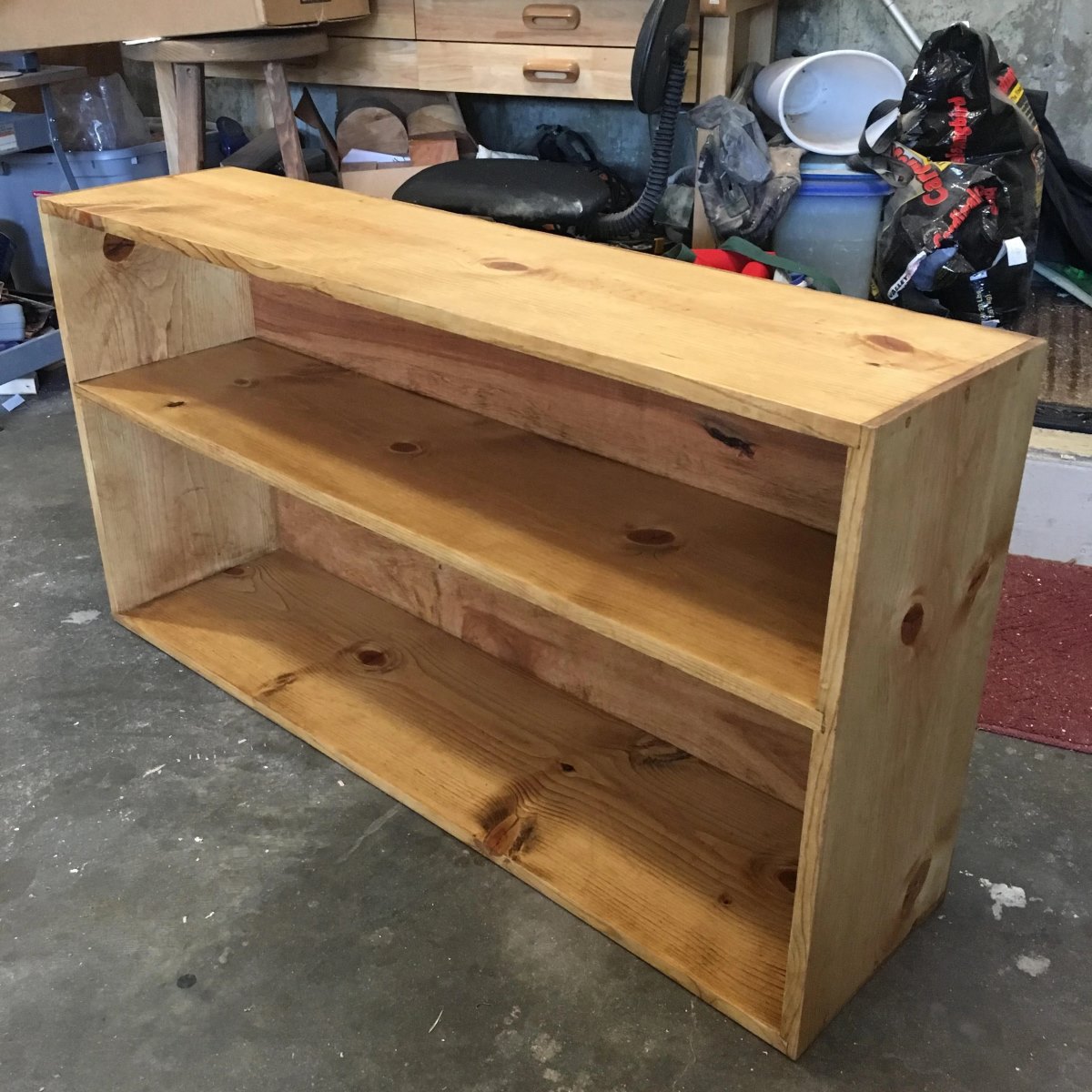

Articles
How Much Should I Charge For Woodworking
Modified: December 7, 2023
Find out how much you should charge for your woodworking articles. Explore pricing strategies and maximize your profits with our expert advice.
(Many of the links in this article redirect to a specific reviewed product. Your purchase of these products through affiliate links helps to generate commission for Storables.com, at no extra cost. Learn more)
Introduction
Woodworking is a skilled craft that requires precision, creativity, and a keen attention to detail. Whether you are a professional woodworker or a hobbyist looking to monetize your passion, determining how much to charge for your woodworking projects can be a daunting task. Pricing your work accurately is crucial to ensuring that you are compensated fairly for your time, expertise, and the cost of materials. In this article, we will discuss various factors to consider when determining the pricing for your woodworking projects.
Every woodworking project is unique, and the cost can vary depending on factors such as the complexity of the design, the type of wood used, and the time required to complete the project. Before you can determine the appropriate pricing for your work, it is important to carefully consider these key factors.
The first step in pricing your woodworking projects is calculating the cost of materials. This includes the price of the wood itself, any additional materials such as hardware or finishes, and any specialized tools or equipment that may be required for the project. By accurately estimating the material costs, you can ensure that you are not undercharging for your work.
Next, you need to calculate the labor costs involved in the project. This includes not only the time spent actually working on the project but also any time spent on design, planning, and finishing touches. It is essential to value your time and expertise appropriately to ensure that you are compensated fairly for your skills.
In addition to material and labor costs, it is important to factor in overhead expenses. These include costs such as electricity, tool maintenance, workshop rent or mortgage, insurance, and advertising. While these costs may not be directly related to a specific project, they are still a part of running your woodworking business and should be factored into your pricing.
Pricing for profit is a vital consideration. It is essential to account for the profit you want to make on each project. This ensures that your business remains sustainable and allows for growth and reinvestment in your craft. It is important to strike a balance between offering competitive pricing and ensuring that your work is profitable.
Market demand is another crucial factor to consider when determining pricing for your woodworking projects. If there is high demand for your work or if you have developed a unique niche in the market, you may be able to charge a premium for your projects. On the other hand, if the market is saturated with similar products, you may need to adjust your pricing accordingly to remain competitive.
To establish a competitive pricing strategy, it is essential to research your competitors. Take the time to analyze what others in your field are charging for similar projects. This will give you valuable insights into market trends and help you make informed decisions about your own pricing.
Offering discounts or package deals can be a great way to attract customers and increase sales. Consider offering discounts for repeat customers, referrals, or bundled projects. This can help you build strong relationships with your clients while also boosting your revenue.
Finally, effectively communicating your pricing to customers is crucial. Be transparent about your pricing structure and provide detailed quotes that clearly outline the costs involved. This will help build trust with your customers and demonstrate the value and quality of your work.
As a woodworker, setting the right price for your projects can be challenging. By considering factors such as materials, labor, overhead expenses, profit, market demand, competitor pricing, discounts, and clear communication, you can ensure that you are pricing your woodworking projects accurately and fairly. Remember, your expertise and craftsmanship deserve to be rewarded, so don’t undervalue your work. With thorough research and careful consideration, you can find the perfect balance between customer satisfaction and financial success in the woodworking industry.
Key Takeaways:
- Pricing woodworking projects requires careful consideration of factors such as material costs, labor, overhead expenses, and market demand to ensure fair compensation and profitability.
- Offering discounts, transparent communication, and adapting to market dynamics are essential strategies for attracting customers, increasing sales, and fostering long-term relationships in the woodworking industry.
Read more: How Much Should I Charge For Home Repairs
Factors to Consider for Pricing Woodworking Projects
Pricing your woodworking projects requires careful consideration of several key factors. By taking these factors into account, you can ensure that you are setting the right price for your work, allowing you to be fairly compensated for your time, expertise, and the cost of materials. Here are some factors to consider when determining the pricing for your woodworking projects:
- Complexity of the Project: The complexity of the design and construction of your woodworking project will have a significant impact on the pricing. Projects that require intricate joinery, detailed carving, or complex assembly will require more time and skill, warranting a higher price.
- Type of Wood Used: The type of wood used in your project will also affect the price. Exotic or rare woods tend to be more expensive than common ones. Consider the cost of the raw materials when calculating the overall price.
- Time and Labor: The amount of time and labor required to complete a project is a major factor in pricing. Consider the hours spent on design, planning, and completing the project. Factor in the price you want to pay yourself for your time and expertise.
- Overhead Expenses: Don’t forget to include overhead expenses in your pricing. This includes costs such as electricity, tool maintenance, workshop rent, insurance, and advertising. As a business owner, these costs should be covered by your pricing to ensure profitability.
- Profit Margin: Determine the profit margin you want to achieve with each project. This will allow you to grow your business and reinvest in your craft. Consider the value you are providing to your customers and set your pricing accordingly.
- Market Demand: The demand for your woodworking projects in the market will also play a role in setting the price. If there is high demand or a niche market for your work, you may be able to charge premiums. However, if there is stiff competition or low demand, you may need to adjust your pricing to stay competitive.
- Research Competitor Pricing: Analyze what other woodworkers are charging for similar projects. This will give you insights into current market trends and help you position your pricing strategy. Consider the quality of your work, materials used, and your unique selling points to differentiate yourself from competitors.
- Discounts or Package Deals: Offering discounts or package deals can be an effective way to attract customers and increase sales. Consider offering discounts for repeat customers, referrals, or bundled projects. This can help you build loyalty and generate more revenue.
- Communication: Clearly communicate your pricing structure to your customers. Provide detailed quotes that outline the costs involved, so there are no surprises. Transparency in pricing builds trust and ensures both parties are on the same page.
By considering these factors, you can confidently determine the appropriate pricing for your woodworking projects. Remember to value your expertise, craftsmanship, and the time invested in each piece. Balancing competitive pricing with fair compensation will help you succeed in the woodworking industry.
Determining the Cost of Materials
When pricing your woodworking projects, accurately determining the cost of materials is essential. The cost of materials plays a significant role in determining the overall price of your project and ensuring that you are adequately compensated for the resources used. Here are some important factors to consider when determining the cost of materials:
1. Wood Selection: The type of wood that you choose for your project will have a direct impact on its cost. Different types of wood vary in price due to factors such as rarity, availability, and quality. Exotic or specialty woods often command a higher price, while more common woods may be more affordable.
2. Quantity: The amount of wood needed for your project will influence the cost. Determine the necessary amount of wood for each component of the project, accounting for waste, joinery, and any potential errors or mistakes. Calculate the cost based on the current market price per board foot or per unit of measurement.
3. Grade and Quality: Within each type of wood, there are different grades and qualities available. Higher-quality wood typically has fewer imperfections, such as knots or blemishes, and may exhibit more desirable characteristics, such as consistent color or grain pattern. Higher-grade wood will generally cost more than lower-grade options.
4. Additional Materials: Consider any additional materials that will be required to complete your project. This may include hardware, such as hinges, handles, or fasteners, as well as finishes, adhesives, and other consumable items. Factor in the cost of these materials when calculating the overall cost.
5. Waste and Scrap: In woodworking, there is often a certain amount of waste generated during the construction process. This can be from trimming, shaping, or errors that result in unusable pieces. Account for waste when determining the cost of materials to ensure that you are covering the actual amount of wood used in the project.
6. Supplier Discounts: If you have established relationships with wood suppliers, it’s worth inquiring about any potential discounts or bulk pricing options. Buying materials in larger quantities may result in cost savings, so be sure to explore these possibilities to reduce your overall expenses.
7. Market Fluctuations: Keep in mind that the price of wood can fluctuate over time. Various factors, including supply and demand, seasonal availability, and global economic conditions, may influence the cost of materials. Stay informed about market trends and factor in any potential price fluctuations when quoting the cost of materials.
By carefully considering these factors, you can more accurately determine the cost of materials for your woodworking projects. This will help you set appropriate pricing that reflects the resources used and ensures that you are properly compensated for your work and investment. Regularly reviewing and updating your material cost calculations will help you stay competitive and profitable in the woodworking industry.
Calculating Labor Costs
When pricing woodworking projects, accurately calculating labor costs is crucial to ensure that you are compensated fairly for your time and expertise. Determining labor costs requires careful consideration of various factors related to the time and effort invested in the project. Here are some key points to consider when calculating labor costs for your woodworking projects:
1. Time: Begin by estimating the total amount of time required to complete the project from start to finish. This includes not only the time spent physically working on the project but also the time spent on design, planning, sourcing materials, and finishing touches. Break down the project into specific tasks and allocate a reasonable amount of time for each task.
2. Hourly Rate: Determine the hourly rate that you believe adequately reflects your skill level, experience, and the value you bring to each project. Consider factors such as the complexity of the project, your expertise, and the market demand for your work. It’s important to set a rate that is competitive yet fair compensation for your time and knowledge.
3. Skill Level: Assess the level of skill required for the project. Certain projects may require advanced woodworking techniques, intricate joinery, or specialized knowledge. Projects that demand a higher skill level should warrant a higher labor rate compared to simpler projects that require less expertise.
4. Efficiency: Take into account your efficiency and experience when estimating labor costs. As you gain more experience and improve your skills, you may become more efficient at completing tasks. This increased efficiency can influence the time required for a project and, therefore, the overall labor cost.
5. Project Complexity: Consider the complexity of the project and the level of attention to detail required. Projects that involve intricate designs, intricate joinery, or multiple components may require more time and effort to complete. Take into account the additional intricacies and allocate the appropriate labor cost accordingly.
6. Overhead Allocation: It’s important to allocate a portion of your labor costs towards covering overhead expenses. Overhead expenses include items such as workshop rent, utilities, insurance, and equipment maintenance. By factoring these costs into your labor rate, you ensure that your business remains profitable and sustainable.
7. Market Demand: Consider the demand for your woodworking projects in the market. If you have a unique niche or a high-demand product, you might consider charging a premium for your labor. Conversely, if the market is saturated or there is a low demand for your work, your pricing may need to be adjusted to remain competitive.
8. Profit Margin: Ensure that your labor costs include an appropriate profit margin. Your labor costs should not only cover your time but also allow for business growth, reinvestment in tools and equipment, and personal income. Determine the profit margin you want to achieve and factor this into your labor rate.
By carefully considering these factors, you can calculate labor costs that accurately reflect the time, expertise, and value you bring to your woodworking projects. Remember, it’s important to set a labor rate that both rewards your skills and knowledge while remaining competitive in the market. Regularly reassess your labor costs to ensure that your pricing remains fair and aligns with the changing demands and dynamics of the woodworking industry.
Factoring in Overhead Expenses
When setting prices for your woodworking projects, it is crucial to factor in overhead expenses. Overhead expenses refer to the ongoing costs of running your woodworking business that are not directly tied to a specific project. Ignoring these expenses can lead to underestimating your true costs and ultimately impact your profitability. Here are some key points to consider when factoring in overhead expenses:
1. Workshop Rent or Mortgage: If you have a dedicated workshop space, include the cost of rent or mortgage payments in your overhead expenses. This is an essential part of your business operation and should be factored into your pricing to ensure you can cover this fixed cost.
2. Utilities and Maintenance: Consider the costs associated with utilities such as electricity, heating, and water for your workshop. Additionally, account for ongoing equipment maintenance costs, such as sharpening tools, replacing blades, or repairing machinery. These expenses keep your workspace operational and should be included in your pricing structure.
3. Insurance: Insurance is an important expense to protect your business from unforeseen circumstances. This includes general liability insurance, equipment insurance, and, if applicable, workers’ compensation insurance. Allocate a portion of your overhead expenses towards insurance coverage.
4. Advertising and Marketing: Include the costs associated with advertising and marketing your woodworking business. This may encompass expenses related to online advertising, printed materials, website development, and social media promotion. Invest in promoting your business to attract new customers, and factor these costs into your pricing to ensure they are covered.
5. Professional Fees and Licenses: Take into account any professional fees or licenses required for your woodworking business, such as accounting or legal services. These fees are important to ensure compliance and the smooth operation of your business.
6. Office Supplies and Administration: Don’t forget to include the cost of office supplies, such as paper, ink, and stationery, as well as any administrative expenses. This may include bookkeeping software, invoicing systems, or hiring administrative assistance. These costs contribute to the overall functioning of your business and should be accounted for in your pricing.
7. Equipment Depreciation: Over time, your woodworking equipment will depreciate in value. To ensure that your pricing accounts for this, calculate equipment depreciation and allocate a portion towards overhead expenses. This will help you cover the eventual replacement or repair costs of your tools and machinery.
8. Contingency Fund: It’s wise to set aside a portion of your overhead costs as a contingency fund. This serves as a buffer for unexpected expenses or emergencies that may arise during the course of running your woodworking business.
By factoring in these overhead expenses, you gain a comprehensive understanding of the true costs of running your woodworking business. Including these costs in your pricing structure ensures that you can cover all expenses and still be profitable. Regularly review and adjust your overhead expense calculations to accurately reflect the current costs of running your business.
Read more: What Hand Tools Should I Buy
Pricing for Profit
When setting prices for your woodworking projects, it’s crucial to consider profitability. While it’s essential to offer fair and competitive prices, it’s equally important to ensure that your business remains sustainable and profitable. Pricing for profit involves determining a pricing structure that covers your costs, allows for business growth, and rewards you for your craftsmanship. Here are some key points to consider when pricing for profit:
1. Cost Analysis: Begin by conducting a thorough cost analysis. This includes calculating the cost of materials, labor, and overhead expenses. Accurately determine the direct and indirect costs associated with each project to ensure that you are not undercharging for your work.
2. Value of Expertise: Consider your level of expertise and the unique skills you bring to your woodworking projects. Your craftsmanship and years of experience deserve to be appropriately compensated. Factor in the value of your experience, creativity, and attention to detail when setting your prices.
3. Time Efficiency: As you gain experience and refine your woodworking techniques, you will likely become more efficient in completing projects. Take into account your time efficiency and how it may affect your pricing. However, be cautious not to undervalue your time and expertise simply because you can complete a project quickly.
4. Profit Margin: Determine the profit margin you want to achieve with each project. This margin allows you to generate revenue to reinvest in your business, purchase new tools and equipment, and reward yourself for the time and effort invested. Consider your industry’s standard profit margin and ensure your pricing aligns with your desired profitability.
5. Business Growth: Pricing for profit allows your woodworking business to thrive and grow. By setting prices that cover your costs and generate profit, you create a foundation for expansion and investment in your craft. Reinvesting in your business through new equipment, marketing efforts, or skill development can lead to future success.
6. Market Positioning: Consider your market positioning when pricing for profit. It’s essential to understand the perceived value of your woodworking in comparison to your competitors. If you have a unique niche or specialize in high-end, custom work, you may be able to charge premium prices. However, if your market is more price-conscious, you may need to adjust your pricing strategy accordingly.
7. Competitive Analysis: Research your competitors and analyze their pricing. Understanding the price points in the market will help you position your own pricing structure. Consider factors such as the quality of your work, your unique selling points, and the value you provide to customers when determining your competitive pricing.
8. Customer Perception: Keep in mind that customers often associate price with quality. Pricing your work too low may lead customers to question the value and quality of your woodworking. While it’s important to remain competitive, ensure that your prices accurately reflect the craftsmanship, materials used, and unique aspects of your projects.
By pricing for profit, you create a sustainable and thriving woodworking business. Be diligent in your cost analysis, factor in your expertise and unique skills, and set prices that cover your expenses while allowing for growth and profitability. Regularly review and adjust your pricing strategy to ensure it aligns with your business goals and the evolving dynamics of the woodworking industry.
Consider the cost of materials, time spent, and your skill level when determining your woodworking pricing. Research similar products to gauge market value and adjust accordingly.
Considering Market Demand
When setting prices for your woodworking projects, it’s essential to consider the market demand for your work. Understanding the current market trends and the demand for your products can help you determine the appropriate pricing strategy. Here are some key points to consider when evaluating market demand:
1. Identifying Your Target Market: Define your target market based on the type of woodworking projects you create. Consider factors such as the style, design aesthetic, and functionality of your work. Understanding your target market will give you insights into their preferences, expectations, and buying behaviors.
2. Researching Industry Trends: Stay up to date with the latest industry trends and customer preferences. This includes following woodworking publications, attending trade shows and exhibitions, and engaging with fellow woodworkers. Being knowledgeable about industry trends allows you to align your pricing with current market demands.
3. Niche Opportunities: Look for niche opportunities within the woodworking market. By specializing in a specific type of woodworking, such as custom furniture, handmade kitchenware, or wooden home decor, you can cater to a specific target market and potentially charge higher prices due to the specialized nature of your work.
4. Unique Selling Proposition: Identify your unique selling proposition (USP) that sets you apart from competitors. Whether it’s your exceptional craftsmanship, sustainable materials, or innovative designs, highlighting your USP can generate demand and justify higher prices for your woodworking projects.
5. Analyzing Competition: Research and analyze your competition to gain insights into their pricing and market positioning. Compare the quality of their work, materials used, and customer base to understand how they differentiate themselves. This analysis will help you gauge the market demand for your own woodworking projects.
6. Customer Feedback: Actively seek customer feedback and testimonials to understand their perceptions of your woodworking projects. This feedback can provide valuable insights into the demand for your work and help you identify areas for improvement or opportunities to further satisfy your customers’ needs.
7. Pricing for Perceived Value: Perceived value plays a significant role in a customer’s willingness to pay for your woodworking projects. Consider how your pricing reflects the perceived value of your work. Quality craftsmanship, unique designs, and the use of premium materials can justify higher prices if the market perceives your work as valuable.
8. Adapting to Market Changes: Continuously monitor the market for changes in customer preferences, emerging trends, and shifts in demand. Be flexible in adapting your pricing strategy to align with these changes. This will help you stay relevant and meet the evolving needs of your target market.
By considering market demand, you can set prices that are both competitive and reflective of the value customers place on your woodworking projects. Stay informed about industry trends, understand your target market, differentiate yourself from competitors, and adapt to market changes to ensure your pricing remains aligned with customer demand.
Researching Competitor Pricing
When determining the pricing for your woodworking projects, researching competitor pricing is a valuable strategy. Understanding what your competitors are charging for similar products allows you to position your own prices effectively and make informed decisions. Here are some key points to consider when researching competitor pricing:
1. Identify Your Competitors: Begin by identifying who your main competitors are in the woodworking industry. Look for businesses or individual woodworkers offering similar products or targeting the same customer base. This could include local artisans, online retailers, or established woodworking businesses in your area.
2. Examine Similar Products: Analyze the woodworking projects or products offered by your competitors that are similar to yours. Consider factors such as the quality of craftsmanship, design complexity, materials used, and overall value provided. This will help you understand how your work compares to theirs and how your pricing should be positioned.
3. Gather Pricing Information: Collect pricing information from your competitors by visiting their websites, online marketplaces, or physical locations. Take note of the prices for different products or services, including any variations in pricing based on size, customization options, or other factors. Capture as much data as possible to gain a comprehensive understanding.
4. Analyze Pricing Strategies: Look beyond just the numbers and analyze the strategies behind your competitors’ pricing decisions. Consider whether they focus on offering low-cost, budget-friendly options or if they position themselves as premium providers with higher-priced products. Understanding their pricing strategies will help you assess the market and determine where you fit in.
5. Consider Quality and Value: Assess the quality and value proposition of your competitors’ offerings. Determine whether their pricing is aligned with the level of craftsmanship, the materials used, and any unique features or benefits they provide. This evaluation will allow you to gauge how your own pricing should correlate to the perceived value of your products.
6. Differentiate Yourself: Identify what sets your woodworking projects apart from those of your competitors. Focus on your unique selling points, such as your design style, customization options, or customer service. This differentiation can justify higher pricing or attract customers who appreciate the added value you bring to the table.
7. Pricing Comparative Analysis: Conduct a comparative analysis of your pricing against that of your competitors. Evaluate how your prices compare to similar offerings in terms of affordability, perceived value, and competitive positioning. This analysis will help you understand whether your pricing is competitive in the market or if adjustments need to be made.
8. Adjusting Pricing Strategy: Based on your competitor research, consider adjusting your pricing strategy if necessary. This can involve setting prices that are slightly higher or lower than your competitors, depending on the unique aspects of your work, your target market, and your overall business goals. Be mindful of maintaining profitability while remaining competitive.
Researching competitor pricing provides valuable insights into the market dynamics and helps you make informed decisions about your own pricing strategy. By understanding your competitors, evaluating their offerings, and positioning yourself effectively, you can set prices that reflect the value you provide and remain competitive in the woodworking industry.
Offering Discounts or Package Deals
Offering discounts or package deals can be an effective strategy for attracting customers, increasing sales, and creating customer loyalty in the woodworking industry. Providing these incentives can help differentiate your business from competitors and provide added value to your customers. Here are some key considerations when offering discounts or package deals:
1. Repeat Customers: Consider offering discounts to customers who have previously purchased from you. Show your appreciation for their loyalty by providing them with a percentage off their next purchase or a special offer exclusive to repeat customers. This encourages customer retention and fosters long-term relationships.
2. Referral Discounts: Encourage your current customers to refer your woodworking services to others by offering referral discounts. Provide a discount or incentive to both the referrer and the person they refer. Word-of-mouth advertising is valuable, and this approach can help grow your customer base organically.
3. Bundle or Package Deals: Create bundled packages for customers who want multiple woodworking items or services. By combining several items or services into a single package, you can offer a discounted price compared to purchasing each item separately. This incentivizes customers to buy more from you and increases the average purchase value.
4. Seasonal or Limited-Time Offers: Introduce seasonal or limited-time offers to create a sense of urgency for customers. Seasonal discounts, such as holiday sales or promotions for specific occasions, can drive sales during peak periods. Limited-time offers create a sense of exclusivity, encouraging customers to make a decision quickly to take advantage of the discounted price.
5. Bulk Discounts: Encourage customers to purchase larger quantities by offering bulk discounts. This is especially applicable for woodworking projects where customers may need multiple items or sets. The discount offered per unit incentivizes customers to buy in larger quantities, benefiting both parties.
6. Customization Options: Consider providing discounts on custom woodworking projects. Offer a lower price for custom orders that may have a longer timeline or require additional design consultation. This encourages customers to invest in personalized pieces and can lead to additional referrals and word-of-mouth recommendations.
7. Seasonal Clearance Sales: Periodically offer clearance sales to move inventory, make space for new projects, or transition between seasons. This can be an opportunity to offer deeper discounts and attract customers looking for special deals. Create a sense of excitement by promoting these sales through your website, social media, and email newsletters.
8. Customer Loyalty Programs: Establish a customer loyalty program to reward repeat customers. This can take the form of a points-based system, where customers earn points for each purchase that can be redeemed for discounts or exclusive perks. Loyalty programs encourage customers to continue purchasing from you and can foster a sense of appreciation and exclusivity.
When offering discounts or package deals, ensure that your pricing still allows for profitability. Carefully calculate the discounted price to cover your costs while providing an attractive offer to customers. Clearly communicate the discounted pricing and terms to customers to avoid confusion or misunderstandings.
By implementing these strategies, you can incentivize customers to choose your woodworking services, increase customer satisfaction, and foster long-term relationships. Offering discounts or package deals can give your business a competitive edge and help you stand out in the woodworking industry.
Communicating Pricing to Customers
Effectively communicating your pricing to customers is crucial to establishing transparency, building trust, and ensuring a positive customer experience. Clear and transparent pricing helps customers understand the value they are receiving and makes the purchasing process smoother. Here are some key points to consider when communicating your pricing to customers:
1. Clearly Display Prices: Make sure that your prices are clearly displayed and easily accessible. Whether on your website, in-store, or on marketing materials, prices should be visible and easy to find. Avoid any ambiguity or confusion by using clear and concise language to describe your pricing structure.
2. Provide Detailed Quotes: When providing quotes for custom woodworking projects, ensure that they are detailed and itemized. Break down the costs of materials, labor, and any additional services or features. This helps customers understand exactly what they are paying for and reinforces the value they will receive.
3. Explain the Value: When communicating your pricing, it’s important to explain the value customers will receive. Highlight the quality of your craftsmanship, the unique aspects of your designs, and the materials used. Educate customers about the expertise, time, and resources invested in each project to justify the price.
4. Offer Options: Present customers with different pricing options or tiers to cater to various budgets and needs. This allows customers to choose the option that best fits their preferences and financial capabilities. Clearly outline the differences in features, quality, or customization in each option to help customers make an informed decision.
5. Be Transparent about Additional Costs: If there are any additional costs that may arise during the project, such as rush fees, customization charges, or shipping costs, communicate them upfront. Avoid surprising customers with unexpected expenses by providing a clear breakdown of all potential costs from the beginning.
6. Address Frequently Asked Questions: Anticipate common questions or concerns about your pricing and address them proactively. Create a FAQ section on your website or include a pricing guide that addresses questions related to payment options, discounts, project timelines, and any potential additional fees. This allows customers to find answers easily and reduces the likelihood of confusion or misunderstandings.
7. Personalize Pricing Discussions: When discussing pricing with potential customers, take the time to personalize the conversation. Listen to their specific needs and requirements and tailor your pricing accordingly. Show empathy and understanding, and be open to negotiation within reason. Building a rapport with customers can help establish trust and a positive business relationship.
8. Follow Up with Exceptional Service: After pricing has been communicated and a project is underway, continue to provide exceptional service to reinforce the value customers are receiving. Deliver on your promises, meet deadlines, and maintain open and transparent communication throughout the process. This enhances the overall customer experience and increases the perceived value of your work.
By effectively communicating your pricing to customers, you create a transparent and trust-building environment. Be clear, detailed, and transparent about your pricing structure, highlight the value customers will receive, and address any concerns or questions they may have. Remember, transparent communication instills confidence and fosters long-term customer relationships.
Conclusion
Pricing woodworking projects requires careful consideration of various factors to ensure that you are fairly compensated for your craftsmanship, materials, and time. By taking into account the complexity of the project, the cost of materials, labor, overhead expenses, market demand, competitor pricing, and offering discounts or package deals, you can establish a pricing strategy that is competitive yet profitable.
Determining the cost of materials is essential for accurately pricing your woodworking projects. Consider factors such as wood selection, quantity needed, grade and quality, additional materials, waste, and supplier discounts. Accurately calculating labor costs involves considering the time invested, skill level required, efficiency, project complexity, overhead allocation, market demand, and profit margin.
Factoring in overhead expenses helps ensure that your pricing covers all the necessary costs of running your woodworking business, such as workshop rent, utilities, insurance, and marketing. Pricing for profit involves determining a pricing structure that not only covers your costs but allows for business growth and rewards your expertise and craftsmanship.
Considering market demand is crucial for setting appropriate prices. Research industry trends, understand your target market, analyze competition, and differentiate yourself to align your pricing with customer expectations and the perceived value of your work.
By researching competitor pricing, you can assess the market and make informed decisions about your own pricing. Analyze similar products, examine pricing strategies, and differentiate yourself by offering unique value to customers.
Offering discounts or package deals can be an effective way to attract customers, incentivize multiple purchases, and foster customer loyalty. Consider offering discounts to repeat customers, referral rewards, bundled packages, seasonal promotions, or bulk discounts to increase sales and customer satisfaction.
Transparently communicating your pricing to customers is essential for building trust and ensuring a positive customer experience. Display prices clearly, provide detailed quotes, explain the value customers will receive, offer pricing options, be transparent about additional costs, address frequently asked questions, personalize pricing discussions, and follow up with exceptional service to reinforce customer satisfaction.
In conclusion, pricing woodworking projects requires a careful balance between covering costs, remaining competitive, and ensuring profitability. By considering all the factors outlined in this article and adapting to market dynamics, you can set appropriate prices that reflect the value of your craftsmanship, meet customer expectations, and help your woodworking business thrive in a competitive market.
Frequently Asked Questions about How Much Should I Charge For Woodworking
Was this page helpful?
At Storables.com, we guarantee accurate and reliable information. Our content, validated by Expert Board Contributors, is crafted following stringent Editorial Policies. We're committed to providing you with well-researched, expert-backed insights for all your informational needs.














0 thoughts on “How Much Should I Charge For Woodworking”